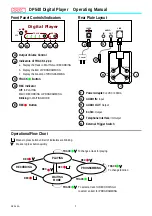
4
Sogenannte Lichtszenarien bieten Ihnen jeweils
eine abgestimmte Kombination von Schalt- und
Dimmvorgängen an den Ausgängen einer Gruppe,
die dieses Szenario dann erzeugen. Sie finden die
Szenarien in der Tabelle von Kapitel 6.
Diese Szenarien werden einfach und komfortabel mit
einem DIP-Schalter (Mäuse-Klavier“) ausgewählt.
Jedes Szenario ist wiederum unterteilt in verschie-
dene Ausführungsarten.
So wird zum Beispiel das Szenario „Straßenlampen“
in die verschiedenen Beleuchtungsarten unterteilt:
Glühbirnen, Gaslampen, Neonröhre mit Starter.
Selbst eine defekte Lampe kann simuliert werden.
Bei diesem Szenario kann sogar zwischen Glühbir-
nen oder LEDs in den Modelllampen unterschieden
werden. Dies ist notwendig, weil LEDs und Glühbir-
nen unterschiedlich auf die Steuerung durch den
Lichtdecoder reagieren.
Die besten Ergebnisse erhalten Sie bei den Lichtef-
fekten, die schnelle Lichtwechsel haben, natürlich mit
LEDs. Glühbirnchen können den schnellen Wechseln
wegen ihrer thermischen Trägheit nicht folgen.
Die jeweilige Ausführungsart der Effekte wählen
Sie ebenfalls komfortabel mit dem DIP-Schalter der
entsprechende Gruppe.
Jeder Ausgang kann nach Bedarf zusätzlich gedimmt
werden, um die Helligkeit zu begrenzen (s. CV 120 ff.).
Die Geschwindigkeit der Effekte kann in den CVs 41
bis 44 für jede Gruppe eingestellt werden.
Der Decoder ist vorgesehen zum Schalten von
Lasten wie Glühbirnen und LEDs.
Eine an kleine Glühbirnen angepasste Überlaster-
kennung ist vorhanden.
2.2 Schnellstart
Schließen Sie den Decoder gemäß Abb. 1 an. Der Deco-
der benötigt eine externe Versorgung (z. B. Art. 5200).
In Werkseinstellung können Sie die Ausgänge des
Lichtdecoders mit der Adressgruppe 1 – 4 im DCC-
Format aktivieren und deaktivieren.
Verwenden Sie das Märklin-Motorola-Format, so
müssen Sie den Decoder mit der Motorola-Adresse
ausstatten. Drücken Sie die rote Taste einmal so
lange, bis die rote LED „Überlast“ jeder Gruppe blinkt.
Nochmaliges Drücken versetzt den Decoder in den
Motorola-Programmiermodus, die LEDs blinken
schnell. Jetzt kann ein Motorola-Schaltbefehl auf
der gewünschten Adresse übertragen werden und
der Decoder übernimmt die Adresse.
Im reinen Analogbetrieb, ohne Digitalzentrale, müssen
Sie über Taster die Ausgänge aktivieren. Sie können, wie
in Abb. 3, mit dem grünen Taster die Gruppe aktivieren
und mit dem roten Taster die Gruppe wieder deaktivieren.
There are so-called lighting scenarios offering a
synchronised combination of switching and dim-
ming operations at the outputs of a group which
generate this scenario. You will find a survey of all
available scenarios in the table of chapter 6.
You may easily and comfortably select these sce-
narios with a DIP switch (jokingly: “mice piano”).
Each scenario is again divided into different vari-
ations.
The scenario “street lamps” for example is divided
into the different lighting modes: bulbs, gas lamps,
neon tube with starter. Even a defective lamp may
be simulated.
The scenario is capable of distinguishing between
bulbs and LEDs in the model lamps. This is nec-
essary as LEDs and bulbs react differently to the
control by the light decoder.
Of course, you will achieve the best results with
LEDs for those lighting effects having quick chang-
es of light. Bulbs cannot follow the quick changes
due to their thermical inertia.
The respective variation of the effects, too, may be
selected comfortably with the DIP switch of the cor-
responding group.
Each output can be dimmed individually in order to
limit the brightness (see CV 120 ff.).
The effect velocity can be configured in CVs 41 to
44 for each group.
The decoder is designed to switch loads such as
bulbs and LEDs.
An overload detection for small bulbs is included.
2.2 Quickstart
Connect the decoder as shown in fig. 1. The decoder
requires an external power supply (e. g. item 5200).
The factory setting allows you to activate and de-
activate the outputs of the light decoder with the
address group 1 – 4 in the DCC mode.
For operating the decoder in Märklin Motorola
mode you must assign a Motorola address to the
decoder first. Push the red button once until the red
LED “overload” of each group starts to blink.
Another push of the red button puts the decoder
into the Motorola programming mode. Now the
LEDs are blinking quickly and you can issue a
Motorola command to the desired address and the
decoder saves the address.
In a pure analogue environment you have to activate
the outputs by means of push buttons. As displayed
in fig. 3, you can activate the group with the green
push button and deactivate it with the red one.





































